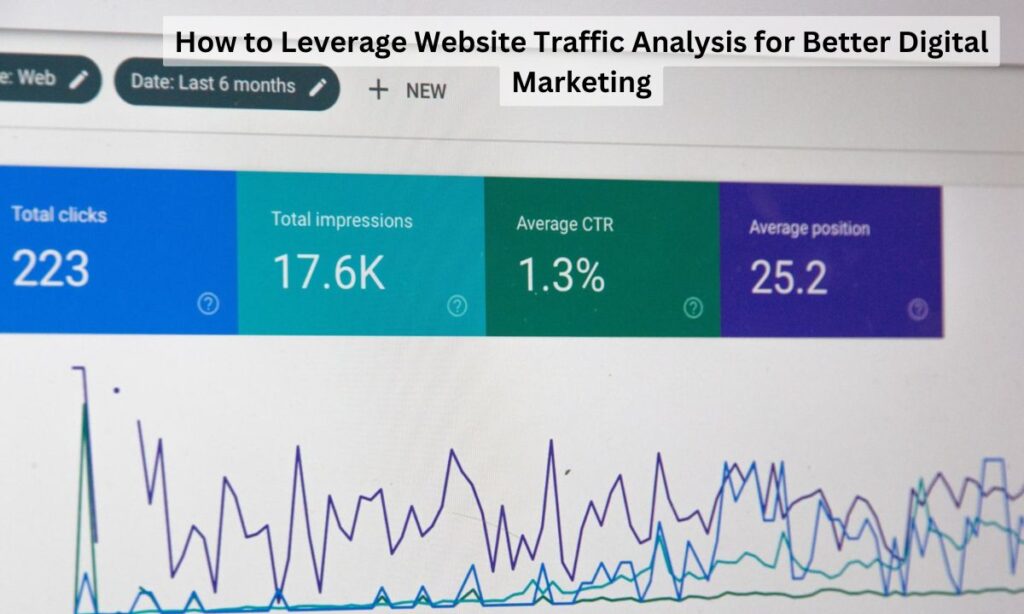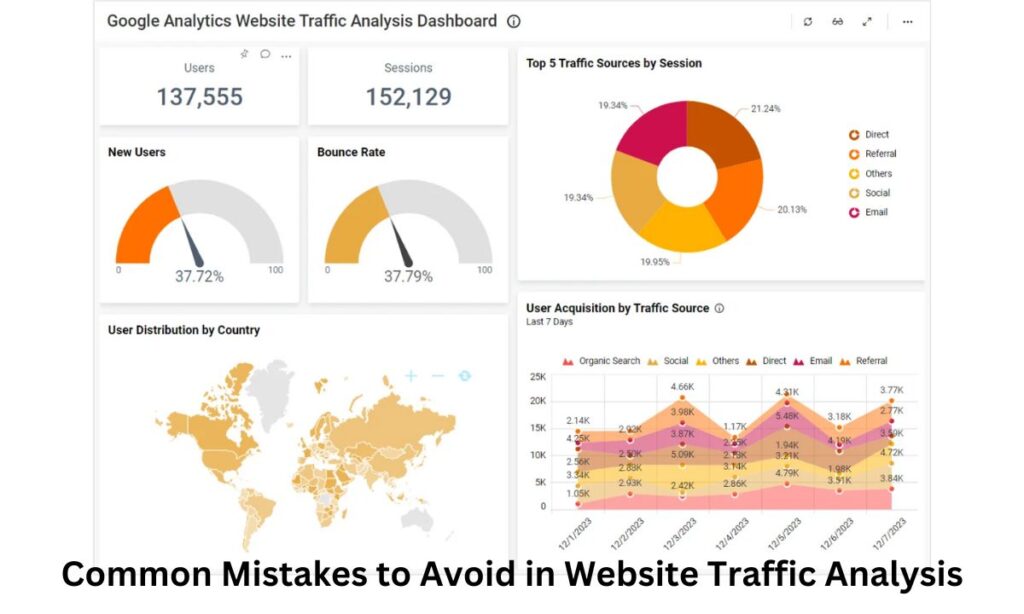In this article, we’ll dive deep into the power of Website Traffic Analysis and how it can propel your digital marketing success.
In today’s digital landscape, understanding your audience and how they interact with your website is essential to a successful digital marketing strategy. Website Traffic Analysis plays a crucial role in unlocking this understanding, providing businesses with valuable insights into user behavior, content performance, and opportunities for improvement. Whether you’re a small business owner or part of a large enterprise, Website Traffic Analysis can help you tailor your marketing efforts for greater efficiency and results.
What is Website Traffic Analysis?
Website Traffic Analysis refers to the process of examining the data related to the visitors coming to your website. This includes metrics such as the number of visitors, page views, bounce rates, average session duration, traffic sources, and more. By collecting and analyzing this data, you gain insights into the behavior of users, their demographics, and how they engage with your website.
Platforms like Google Analytics, SEMrush, and others are commonly used tools for conducting Website Traffic Analysis. They allow marketers to visualize trends, track campaigns, and optimize digital marketing efforts based on real-world data.
Why Website Traffic Analysis is Critical for Digital Marketing Success
In the fast-paced world of digital marketing, data-driven decisions are key to staying ahead of the competition. Here’s why Website Traffic Analysis is so important for digital marketing success:
1. Understanding User Behavior
One of the most significant benefits of Website Traffic Analysis is understanding how users interact with your website. It tells you which pages are most visited, how long users stay on those pages, and what paths they take through your site. With this information, you can identify content that resonates with your audience and areas where users lose interest.
By knowing what works and what doesn’t, you can optimize your content strategy to provide a better user experience and keep visitors engaged. This, in turn, can lead to higher conversions and improved overall website performance.
2. Measuring Marketing Campaign Effectiveness
Another powerful aspect of Website Traffic Analysis is its ability to measure the effectiveness of your digital marketing campaigns. Whether you’re running a pay-per-click (PPC) campaign, email marketing, or social media ads, Website Traffic Analysis helps track how much traffic each channel is driving and what users do after landing on your site.
For example, if you notice a high bounce rate from a particular campaign, it may signal that the landing page or ad copy needs improvement. On the other hand, if certain campaigns lead to more conversions or longer session durations, you can invest more in those channels to maximize results.
3. Identifying Traffic Sources
Website Traffic Analysis breaks down your traffic sources into categories such as organic search, paid search, direct traffic, referral, and social media. Understanding where your traffic is coming from is essential for crafting targeted marketing strategies.
For instance, if organic search traffic is your primary source, you can focus on improving your SEO strategy to capture more relevant search terms. Conversely, if social media traffic is low, you may need to invest more in building your presence and engagement on those platforms. Website Traffic Analysis helps you allocate resources more effectively.
4. Enhancing User Experience
User experience (UX) is one of the most critical factors in a website’s success. If visitors find it difficult to navigate your site, load times are slow, or pages are confusing, they’re more likely to leave without taking any action. Website Traffic Analysis can reveal pain points in the user journey by tracking metrics like bounce rates, time on page, and exit rates.
With this information, you can make data-backed decisions to improve your website’s design, functionality, and content. Enhancing UX not only keeps visitors on your site longer but also increases the chances of conversions, making it a win-win for both your audience and your business.
5. Boosting SEO Performance
Search engine optimization (SEO) is one of the most valuable digital marketing strategies for driving long-term, sustainable traffic. Website Traffic Analysis helps you monitor your SEO efforts by tracking organic traffic growth, keyword rankings, and user engagement metrics from search results.
By analyzing which pages are getting the most organic traffic, you can identify what keywords or topics are performing well. From there, you can refine your SEO strategy, create more content around high-performing topics, and target additional relevant keywords to grow your organic presence.

How to Leverage Website Traffic Analysis for Better Digital Marketing
Now that we’ve covered why Website Traffic Analysis is so important, let’s explore how you can leverage it for better digital marketing results.
1. Set Clear Goals and KPIs
Before diving into Website Traffic Analysis, it’s essential to establish clear goals and key performance indicators (KPIs). These will vary depending on your business and marketing objectives but could include things like increasing conversions, reducing bounce rates, or driving more traffic from specific channels.
Setting measurable goals will help you focus your Website Traffic Analysis on the metrics that matter most, ensuring that your insights are actionable and aligned with your overall digital marketing strategy.
2. Segment Your Audience
Not all website visitors are the same. By segmenting your audience based on factors like demographics, device type, or traffic source, you can uncover deeper insights into different user behaviors. This allows for more personalized marketing approaches that resonate with each audience segment.
For example, mobile users might have different browsing habits than desktop users. Website Traffic Analysis can show you if your mobile visitors have higher bounce rates or shorter session durations, indicating the need for mobile-friendly optimization.
3. Track Conversion Rates
One of the most important aspects of Website Traffic Analysis is tracking conversion rates. Whether your goal is to get visitors to make a purchase, sign up for a newsletter, or download a resource, conversion rates tell you how successful your website is at achieving those goals.
By analyzing the conversion rates of different landing pages, you can make data-driven decisions to optimize your website and improve its overall performance. For example, you might discover that a particular page with a high volume of traffic has a low conversion rate. This could indicate a need to improve the page’s design, content, or call-to-action (CTA).
4. Monitor Traffic Growth Over Time
Regularly monitoring traffic growth is crucial for measuring the long-term success of your digital marketing efforts. Use Website Traffic Analysis to track how your traffic changes over time and correlate those changes with specific marketing activities.
Did you see a spike in traffic after launching a new campaign? Or perhaps traffic dipped after a website redesign? Understanding these patterns will help you refine your strategies and continue improving your digital marketing performance.
5. Conduct A/B Testing
Website Traffic Analysis is also incredibly useful when conducting A/B testing. By comparing different versions of your website, ads, or content, you can determine which variation performs better based on actual user data. This approach helps you optimize your digital marketing campaigns for maximum effectiveness.
For example, you can test different headlines, images, or CTA buttons to see which version drives more conversions. Website Traffic Analysis provides the hard data needed to validate these changes, leading to more informed decision-making.
Common Mistakes to Avoid in Website
While Website Traffic Analysis is a powerful tool, it’s essential to avoid some common pitfalls that could skew your results or lead to poor decision-making.

1. Focusing Solely on Vanity Metrics
It’s easy to get caught up in vanity metrics like page views or total visitors. While these numbers can be impressive, they don’t always translate to business value. Instead, focus on actionable metrics such as conversions, engagement rates, and ROI to gain a more accurate picture of your website’s performance.
2. Ignoring Negative Trends
If your traffic is declining or your bounce rates are increasing, it’s tempting to ignore these negative trends. However, addressing them head-on is key to improving your website’s overall performance. Use Website Traffic Analysis to identify potential issues and develop solutions to reverse these trends.
3. Not Segmenting Data
A common mistake in Website Traffic Analysis is analyzing data in aggregate without segmenting it. Different user segments behave differently, and lumping them all together can lead to misleading conclusions. Always segment your data to get the most accurate insights.
Conclusion: Harnessing the Power of Website Traffic Analysis for Success
Website Traffic Analysis is an indispensable tool for any digital marketer looking to achieve success in today’s competitive landscape. By leveraging the insights gained from traffic data, you can optimize your campaigns, improve user experience, and ultimately boost your conversion rates.
Whether you’re looking to improve your SEO, refine your content strategy, or enhance the overall user experience, Website Traffic Analysis provides the data-driven foundation for informed decision-making. The key to success lies in consistently analyzing, adapting, and optimizing your efforts to stay ahead of the curve.
Start harnessing the power of Website Traffic Analysis today and watch your digital marketing performance soar.
For More Amazing Article Like This You Can keep an eye on: Tech Field

